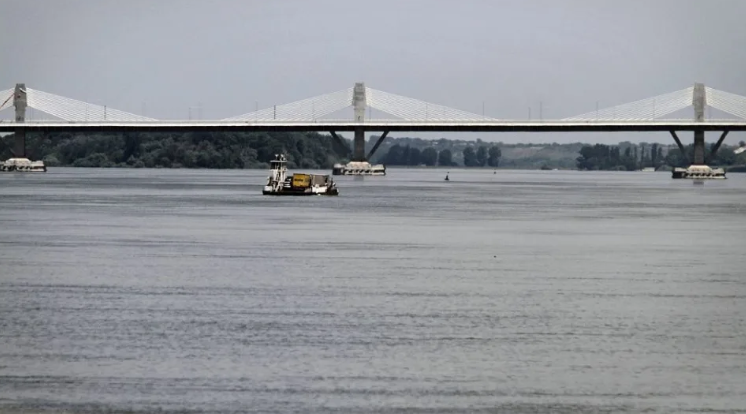
The river is the second-longest in Europe stretching more than 2,800 kms through 10 countries: Germany, Austria, Slovakia, Hungary, Croatia, Serbia, Bulgaria, Romania, Ukraine, and Moldova.
The governments of Bulgaria and Romania are championing the projects as a means to boost their energy sovereignty through the use of an abundant shared resource.
“It is high time that Bulgaria take advantage of this natural resource," Bulgaria's Energy Ministry says on its website. Romania's Energy Minister, Sebastian Burduja, meanwhile told Euronews that the first dam "is considered a profitable investment, with an important capacity of over 800 MW installed power, divided in half with Bulgaria."
'Enormous' impact on local environment
But while there is political alignment for the projects to go ahead, the hydropower plants’ viability raises many questions from an environmental standpoint.
"The impact on that particular border stretch would be enormous. There are hundreds of islands in this part, which are very valuable," Ulrich Eichelmann, the CEO of RiverWatch, a nonprofit monitoring the health of European rivers, told Euronews.
The dams’ construction in the lower part of the Danube would submerge many of these islands. "These areas are most likely the last spawning sites of several sturgeons and also herrings. For all these species, that would be a killer effect until the Black Sea," he added.
The environmental adequacy report evaluating Romania's 2019-2030 Energy Strategy in which the Turnu Magurele-Nikopol project was initially included, raised concerns about two key Natura 2000 protected areas that the plant would cross: Corabia-Turnu Magurele and Suhaia.
These areas hold ecological importance because they feature vital natural and semi-natural habitats, including softwood, willow, and poplar forests. This region also serves as a nesting site for EU Birds Directive-listed species like woodpeckers, yellow herons, and great egrets.
The potential damage extends beyond these protected areas, with downstream landscapes at risk of significant transformation due to the hydropower plants' effects. "When the flowing water is poorer in sediments, which would be retained by the dam, a process of coastal erosion would start, affecting the Delta and the Black Sea, with further consequences for their ecosystems and biodiversity," Camelia Ionescu, WWF Romania’s Freshwater Project Manager, told Euronews.
Stripped of the Danube's sediments and encroached upon by the Black Sea, the Danube Delta would face imminent destruction. The Delta, Europe’s second-largest, is the best preserved on the continent and is a backbone for biodiversity with rich habitats, flora and fauna.
Nuclear safety in jeopardy?
Diminished water flow could also jeopardise Romania's Cernavoda nuclear power plant, situated downstream from both proposed hydropower plants.
The nuclear site relies on Danube water to cool its reactors. With two new reactors planned, the plant's water needs are set to rise. Insufficient supply could elevate accident risks or halt operations.
Finally, the two projects could also clash with others already being evaluated.
"There is already a project between Romania and Bulgaria, called Fast Danube, which has a completed feasibility study, searching for solutions to improve navigation on the Danube," Ionescu from WWF Romania, highlighted.
"There is a conflict, if, on the one hand, we are talking about hydro-technical solutions to improve navigation, while, on the other, we are investing in studies to develop hydropower plants," she said as such plants can greatly disrupt river navigation for vessels.
NGOs look at the EU
For activists, the European Union has a key role to play as the two countries hope to secure EU funds for the projects.
Bulgaria integrated hydro-energy into its Strategic Vision for Sustainable Energy Sector Development in January of this year, outlining its intention to build "870 MW of new hydropower capacity by 2030," closely matching Turnu Magurele-Nikopol hydropower plant’s estimated capacity.
Greenpeace Bulgaria launched legal action against the government over the document, citing its lack of public consultations and a comprehensive environmental assessment, which are typical prerequisites. The legal challenge was dismissed by the court which ruled that the document is not of public interest as it is non-binding.
"Our impression was that they prepared it quickly in order to justify the renegotiation of the National Recovery and Resilience Plan, as it was released exactly at the time when the Parliament wanted to vote to renegotiate the plan and not reduce our CO2 emissions," Meglena Antonova, Greenpeace Bulgaria’s Office Director, told Euronews.
The Recovery and Resilience Facility (RRF) is a €800 billion fund the EU put in place to boost the bloc's economy sickened by the COVID-19 pandemic and which targets investments in green and digital industries.
'Amazing' local revenues
It is not yet clear where the funding for the hydropower plants would come from. The Turnu Magurele-Nikopol plant alone was in 2018 projected to cost over €2 billion euros but given current inflation rates, costs are likely to be significantly higher.
Romania’s Energy Minister alluded to potential European-level options, including the Modernisation Fund and transborder cooperation funds.
"We don’t think they can do this with national recovery and resilience funding. They will have to have strict approval for these EU funds," said Antonova from Greenpeace Bulgaria.
"The EU can play a key role in moderating these types of processes, so that member states do not enter mega-projects without truly looking their feasibility and sustainability, not because of investor promises," she added.
Locals, however, appear enthusiastic about the hydropower plants despite recognising their environmental impact.
“This project would ensure salaries and taxes for the local budgets, which would be amazing," Angela Dobre, a Turnu Magurele resident running a local development nonprofit, told Euronews. She was a construction internwhen the project’s first iteration started in the final years of communism, but was never completed.
This type of project could breathe new life into an aging city with limited youth opportunities. "Such a large-scale endeavor would require numerous specialists. There would be an enormous apparatus working there," she said.